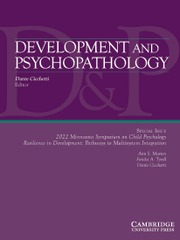Crossref Citations
This article has been cited by the following publications. This list is generated based on data provided by
Crossref.
Frick, Paul J.
and
Ellis, Mesha
1999.
Callous-Unemotional Traits and Subtypes of Conduct Disorder.
Clinical Child and Family Psychology Review,
Vol. 2,
Issue. 3,
p.
149.
Fergusson, David M.
Woodward, Lianne J.
and
Horwood, L. John
1999.
Childhood Peer Relationship Problems and Young People's Involvement with Deviant Peers in Adolescence.
Journal of Abnormal Child Psychology,
Vol. 27,
Issue. 5,
p.
357.
Fergusson, David M
Woodward, Lianne J
and
Horwood, L John
1999.
Gender differences in the relationship between early conduct problems and later criminality and substance abuse.
International Journal of Methods in Psychiatric Research,
Vol. 8,
Issue. 4,
p.
179.
Frick, Paul J.
and
Loney, Bryan R.
1999.
Handbook of Disruptive Behavior Disorders.
p.
507.
Giancola, Peter R.
and
Mezzich, Ada C.
2000.
Executive cognitive functioning mediates the relation between language competence and antisocial behavior in conduct-disordered adolescent females.
Aggressive Behavior,
Vol. 26,
Issue. 5,
p.
359.
Frick, Paul J.
2000.
A comprehensive and individualized treatment approach for children and adolescents with conduct disorders.
Cognitive and Behavioral Practice,
Vol. 7,
Issue. 1,
p.
30.
Kilgore, Kim
Snyder, James
and
Lentz, Chris
2000.
The contribution of parental discipline, parental monitoring, and school risk to early-onset conduct problems in African American boys and girls..
Developmental Psychology,
Vol. 36,
Issue. 6,
p.
835.
Maughan, Barbara
Pickles, Andrew
Rowe, Richard
Costello, E. Jane
and
Angold, Adrian
2000.
Developmental Trajectories of Aggressive and Non-Aggressive Conduct Problems.
Journal of Quantitative Criminology,
Vol. 16,
Issue. 2,
p.
199.
LOEBER, ROLF
BURKE, JEFFREY D.
LAHEY, BENJAMIN B.
WINTERS, ALAINA
and
ZERA, MARCIE
2000.
Oppositional Defiant and Conduct Disorder: A Review of the Past 10 Years, Part I.
Journal of the American Academy of Child & Adolescent Psychiatry,
Vol. 39,
Issue. 12,
p.
1468.
Lahey, Benjamin B.
Schwab-Stone, Mary
Goodman, Sherryl H.
Waldman, Irwin D.
Canino, Glorisa
Rathouz, Paul J.
Miller, Terri L.
Dennis, Kimberly D.
Bird, Hector
and
Jensen, Peter S.
2000.
Age and gender differences in oppositional behavior and conduct problems: A cross-sectional household study of middle childhood and adolescence..
Journal of Abnormal Psychology,
Vol. 109,
Issue. 3,
p.
488.
Frick, Paul J.
Bodin, S. Doug
and
Barry, Christopher T.
2000.
Psychopathic traits and conduct problems in community and clinic-referred samples of children: Further development of the Psychopathy Screening Device..
Psychological Assessment,
Vol. 12,
Issue. 4,
p.
382.
Gibson, Chris L.
Piquero, Alex R.
and
Tibbetts, Stephen G.
2000.
Assessing the relationship between maternal cigarette smoking during pregnancy and age at first police contact.
Justice Quarterly,
Vol. 17,
Issue. 3,
p.
519.
Aalsma, Matthew C.
and
Lapsley, Daniel K.
2001.
A typology of adolescent delinquency: sex differences and implications for treatment.
Criminal Behaviour and Mental Health,
Vol. 11,
Issue. 3,
p.
173.
Silverthorn, Persephanie
2001.
Handbook of Conceptualization and Treatment of Child Psychopathology.
p.
41.
Frick, Paul J.
and
McCoy, Monique G.
2001.
Handbook of Conceptualization and Treatment of Child Psychopathology.
p.
57.
GOLDSTEIN, RISË B.
PRESCOTT, CAROL A.
and
KENDLER, KENNETH S.
2001.
Genetic and Environmental Factors in Conduct Problems and Adult Antisocial Behavior among Adult Female Twins.
The Journal of Nervous and Mental Disease,
Vol. 189,
Issue. 4,
p.
201.
Salekin, Randall T.
Rogers, Richard
and
Machin, Dayli
2001.
Psychopathy in Youth: Pursuing Diagnostic Clarity.
Journal of Youth and Adolescence,
Vol. 30,
Issue. 2,
p.
173.
Piquero, Alex R
and
Chung, He Len
2001.
On the relationships between gender, early onset, and the seriousness of offending.
Journal of Criminal Justice,
Vol. 29,
Issue. 3,
p.
189.
Stueve, Ann
O'Donnell, Lydia
and
Link, Bruce
2001.
Gender differences in risk factors for violent behavior among economically disadvantaged African American and Hispanic young adolescents.
International Journal of Law and Psychiatry,
Vol. 24,
Issue. 4-5,
p.
539.
Silverthorn, Persephanie
Frick, Paul J.
and
Reynolds, Richard
2001.
Timing of Onset and Correlates of Severe Conduct Problems in Adjudicated Girls and Boys.
Journal of Psychopathology and Behavioral Assessment,
Vol. 23,
Issue. 3,
p.
171.

